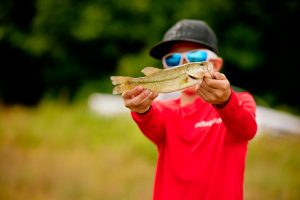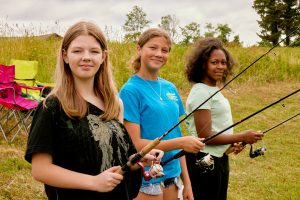Among the successful hunters during Delaware’s record-setting 2023 wild turkey harvest
was Tanner Cobb. Photo courtesy of Rusty Kaiser, Tanner’s grandfather.
Public’s Help Sought on Annual Turkey Productivity Survey
Hunters reported harvesting 785 wild turkeys during Delaware’s month-long spring turkey season – which is 38% more than the total for the 2022 hunting season and a new all-time high harvest for the state, the Delaware Department of Natural Resources and Environmental Control announced today. The total easily eclipsed Delaware’s previous record harvest of 706 turkeys in 2016. The record harvest and plentiful turkey hunting opportunities to be taken advantage of in the First State are testament to the conservation success story of this important species after a restoration effort in the mid-1980s returned the iconic native gamebird to Delaware for the first time since the late 1800s.
Gobbler harvest during each week of the month-long season was similar to previous years, with 365 turkeys harvested during the first week, 149 during the second week, 129 during the third week and 109 during the last week of the season. An additional 33 turkeys were harvested during the special one-day hunting opportunity provided to youth and non-ambulatory adult hunters on the Saturday prior to the opening of the turkey hunting season. Included in this year’s harvest was the largest turkey recorded in Delaware history, weighing in at 27 pounds, 8 ounces.
Delaware allows only the harvest of turkeys with beards – almost always males – during the spring season, which is the only time of year turkeys may be hunted in Delaware, with hunters limited to one turkey per year. Despite their rarity, nine turkey hens with beards were harvested by Delaware hunters in 2023. Other season highlights included the harvest of 32 “non-typical” turkeys, consisting of gobblers with more than one beard. Of the birds sporting multiple beards, 26 had two beards, six turkeys had more than two beards, and one bird was taken with eight individual beards. The longest recorded beard was 13.5 inches, and the longest spurs on a harvested bird were 2.0625 inches on the right leg and 2” on the left leg.
The record-size (27 lbs. 8 oz) gobbler was taken on private property located in Wildlife Management Zone 4 in Kent County. As for harvest distribution, turkeys were taken by hunters this year in 17 of 18 Delaware wildlife management zones. A wild turkey harvest “hot spot” was along a corridor of management zones comprising western Kent County and Sussex County – which together accounted for 83% of the total harvest in the state. Zone 1A, which is in New Castle County north of Interstate 95/I-295, was the only zone where turkeys were not harvested.
This year, 643 turkeys were harvested on privately-owned lands and 135 on public lands (harvest location of seven turkeys is unknown). Beyond the total harvest being the highest in state history, the number of turkeys taken on public land in 2023 is also a record, which should continue drawing interest in the state’s turkey hunting opportunities managed by the DNREC Division of Fish and Wildlife. Quality hunting opportunities on public land continue to be widely available statewide and numerous hunters who seized on them were often rewarded in 2023, as evidenced by turkeys having been harvested from 19 different public land areas.
DNREC Seeks Public Participation on Turkey Productivity Survey
Since 2010, the DNREC Division of Fish and Wildlife has used an annual, volunteer-based survey to record observations of wild turkeys across the state during the months of July and August. This survey generates an index of annual turkey productivity and helps track the health and distribution of the turkey population while evaluating potential regional differences in reproductive success within Delaware. For more information about this important survey, and to obtain the sighting form, visit dnrec.alpha.delaware.gov/fish-wildlife/hunting/wild-turkeys/surveys/.
2024 Spring Turkey Season Dates and Public Lands Lottery Application now Available
For hunters planning ahead, the 2024 wild turkey hunting season will open Saturday, April 13 and run through Saturday, May 11, with the special day for youth and non-ambulatory hunters set for Saturday, April 6. Hunters planning to hunt public lands should submit a public lands turkey lottery application, with information available in the 2023/2024 Delaware Hunting & Trapping Guide. Hunters are required to successfully complete a turkey hunter education class before hunting wild turkeys in Delaware and before applying for a permit to hunt on public lands – more information can be found at de.gov/huntersafety.
Hunting season and state wildlife area information is available in the 2023/2024 Delaware Hunting & Trapping Guide or by calling the DNREC Division of Fish and Wildlife’s Wildlife Section at 302-739-9912. Information on hunting licenses and the Conservation Access Pass is available at de.gov/huntinglicense or by calling the DNREC Division of Fish and Wildlife Recreational Licensing office at 302-739-9918.
About DNREC
The Delaware Department of Natural Resources and Environmental Control protects and manages the state’s natural resources, protects public health, provides outdoor recreational opportunities and educates Delawareans about the environment. The DNREC Division of Fish and Wildlife conserves and manages Delaware’s fish and wildlife and their habitats, and provides fishing, hunting, wildlife viewing and boating access on nearly 68,000 acres of public land owned or managed by the Division of Fish and Wildlife. For more information, visit the website and connect with @DelawareDNREC on Facebook, Instagram, Twitter or LinkedIn.
Media contacts: Michael Globetti, michael.globetti@delaware.gov; Nikki Lavoie, nikki.lavoie@delaware.gov
###


